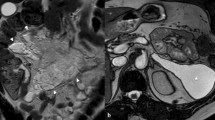Abstracts
The authors report eight cases of biliary duct rhabdomyosarcoma in children, examined by US and CT. There were five boys and three girls, aged 2 to 17 years. At presentation, US demonstrates the tumor mass within the liver or the hepatic hilum; it allows measurement of it and defines the relationship with portal vessels, biliary tract and other important structures. CT complements the US evaluation and determines operability. As US and CT cannot assess the histological origin of the tumor, a biopsy is mandatory before treatment. If complete surgical excision does not seem possible, percutaneous biopsy is preferrable to incomplete excision and its possible complications. During the follow-up period, US can be repeated to measure tumor regression under chemotherapy. After surgery, CT seems preferable because of gas interposition. Both US and CT proved to be valuable for the early detection of local recurrence. The prognosis of these tumors remains bad. However, with more aggressive and hopefully more efficient chemotherapy a precise evaluation of the tumor extension by US and CT is very important. Surgery will then be performed only on localized tumors or on residual masses after chemotherapy.
Similar content being viewed by others
References
Corbineau D, Bertrand G, Dimard C, Plane P, Delaitre R (1975) Sarcome botryoide des voies biliaires chez l'enfant. Ann Pediatr 22: 735
Flamand F, Hill C (1984) The improvement in survival associated with combined chemotherapy in childhood rhabdomyosarcoma. A historical comparison of 345 patients in the same center. Cancer 53: 2417
Kaude JV, Felman AH, Hawkins IF (1980) Ultrasonography in primary hepatic tumors in early childhood. Pediatr Radiol 9: 77
Friedburg H, Kauffmann GW, Bohm N, Fiedler L, Jobke A (1984) Sonography and computed tomography features of embryonal rhabdomyosarcoma of the biliary tract. Pediatr Radiol 14: 436
Smith WL, Franken EA, Mitros FA (1983) Liver tumors in children. Semin Roentgenol 18: 136
Miller JH, Greenspan BS (1985) Integrated imaging of hepatic tumors in childhood. Part I: malignant lesions. Radiology 150: 695
Brunelle F, Chaumont P (1984) Hepatic tumors in children: ultrasonic differentiation of malignant from benign lesions. Radiology 150: 695
Macpherson RI, Saldana JA, Cone RM, Mewborne EB (1981) Primary liver masses in infants. J Can Assoc Radiol 32: 81
Snow JH Jr, Goldstein HM, Wallace S (1979) Comparison of scintigraphy, sonography and computed tomography in the evaluation of hepatic neoplasms. AJR 132: 915
Miller JH, Gates GH, Stanley P (1977) The radiologic investigations of hepatic tumors in childhood. Radiology 124: 451
Author information
Authors and Affiliations
Rights and permissions
About this article
Cite this article
Geoffray, A., Couanet, D., Montagne, J.P. et al. Ultrasonography and computed tomography for diagnosis and follow-up of biliary duct rhabdomyosarcomas in children. Pediatr Radiol 17, 127–131 (1987). https://doi.org/10.1007/BF02388089
Received:
Accepted:
Issue Date:
DOI: https://doi.org/10.1007/BF02388089




